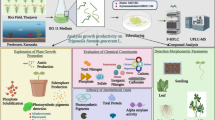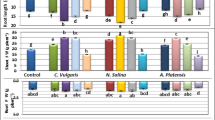Abstract
Develo** new and natural sources of plant growth promotors is essential to ensure the safe and sustainable production of vegetables for human consumption. In recent years, the potential of microalgae as plant biostimulants has been investigated. Arthrospira platensis (Spirulina platensis) biomass is a recognized protein source and its enzymatic hydrolysis contains molecules such as polyamines with potential to promote plant growth. Therefore, the aim of the present study was to investigate the biostimulant properties of hydrolyzed biomass of A. platensis. Bioassays were performed to determine auxin-like and cytokinin-like bioactivity of the hydrolysates. In addition, its effect on lettuce seedling growth was investigated and an organic system field trail performed where yield and free polyamine levels in leaves quantified. The hydrolysates had a cytokinin-like effect in the bioassay. Foliar applications promoted the growth of lettuce seedlings with the 4-h reaction hydrolysate (Sph4) being the most effective at promoting growth and increasing the spermine content by 64% in the lettuce leaves. The polyamine concentration was also compared in non-hydrolyzed A. platensis and Sph4. Hydrolysis resulted in a 34% increase in spermine content. It was concluded that Sph4 is a natural plant growth promoter that can be used as a raw material for biostimulants, and spermine could be an active compound and a metabolic indicator of Sph4 bioactivity.






Similar content being viewed by others
References
Aly MHA, Abd El-All Azza AM, Mostafa SS (2008) Enhancement of sugarbeet seed germination, plant growth, performance and biochemical compounds as contributed by algal extracellular products. J Agric Sci 33:8429–8448
Arioli T, Mattner SW, Winberg PC (2015) Applications of seaweed extracts in Australian agriculture: past, present and future. J Appl Phycol 27:2007–2015
Du Jardin P (2015) Plant biostimulants: definition, concept, main categories and regulation. Sci Hort 196:3–14
Faheed FA, Abd-El Fattah Z (2008) Effect of Chlorella vulgaris as bio-fertilizer on growth parameters and metabolic aspects of lettuce plant. J Agric Soc Sci 4:1813–2235
Flores HE, Galston AW (1982) Analysis of polyamines in higher plants by high performance liquid chromatography. Plant Physiol 69:701–706
Garcia-Gonzalez J, Sommerfeld M (2016) Biofertilizer and biostimulant properties of the microalga Acutodesmus dimorphus. J Appl Phycol 28:1051–1061
Hernández-Herrera RM, Santacruz-Ruvalcaba F, Ruiz-López MA, Norrie J, Hernández-Carmona G (2013) Effect of liquid seaweed extracts on growth of tomato seedlings (Solanum lycopersicum L.) J Appl Phycol 26:619–628
Hosoya R, Hamana K, Isobe M, Yokota A (2005) Polyamine distribution profiles within cyanobacteria. Microbiol Cult Coll 21:3–8
Hussain A, Hasnain S (2011) Phytostimulation and biofertilization in wheat by cyanobacteria. J Ind Microbiol Biotechnol 38:85–92
Incharoensakdi A, Jantaro S, Raksajit W, Mäenpää P (2010) Polyamines in cyanobacteria: biosynthesis, transport and abiotic stress response. In: Méndez-Vilas A (ed) Current research, technology and education topics in applied microbiology and microbial biotechnology. Formatex, Spain, pp 23–32
Kim NH, Jung SH, Kim SH, Ahn HJ, Ong KB (2014) Purification of an iron-chelating peptide from Spirulina protein hydrolysates. J Korean Soc Appl Biol Chem 57:91–95
Kusano T, Berberich T, Tateda C, Takahashi Y (2008) Polyamines: essential factors for growth and survival. Planta 228:367–381
Lima GPP, Rocha AS, Takaki M, Ramos PRR, Ono EO (2008) Comparison of polyamine, phenol and flavonoid contents in plants grown under conventional and organic methods. Int J Food Sci Technol 43:1838–1843
Lisboa CR, Pereira AM, Costa JAV (2016) Biopeptides with antioxidant activity extracted from the biomass of Spirulina sp. LEB 18. Afr J Microbiol Res 10:79–86
Mattoo AK, Minocha SC, Minocha R, Handa AK (2010) Polyamines and cellular metabolism in plants: transgenic approaches reveal different responses to diamine putrescine versus higher polyamines spermidine and spermine. Amino Acids 38:405–413
Mehta RA, Cassol T, Li N, Ali N, Handa AK, Mattoo AK (2002) Engineered polyamine accumulation in tomato enhances phytonutrient content, juice quality, and vine life. Nat Biotechnol 20:613–618
Osman MEH, El-Sheekh MM, El-Naggar AH, Gheda SF (2010) Effect of two species of cyanobacteria as biofertilizers on some metabolic activities, growth, and yield of pea plant. Biol Fertil Soils 46:861–875
Pandey S, Ranade SA, Nagar PK, Kumar N (2000) Role of polyamines and ethylene as modulators of plant senescence. J Biosci 25:291–299
Papenfus HB, Stirk WA, Finnie JF, Van Staden J (2012) Seasonal variation in the polyamines of Ecklonia maxima. Bot Mar 55:539–543
Povero G, Mejia JF, Tommaso DD, Piaggesi A, Warrior P (2016) A systematic approach to discover and characterize natural plant biostimulants. Front Plant Sci. doi:10.3389/fpls.2016.00435
Rakova NY, Romanov GA (2005) Polyamines suppress manifestation of cytokinin primary effects. Russ J Plant Physiol 52:50–57
Reichert CC, Reinehr CO, JAV C (2006) Semicontinuous cultivation of the cyanobacterium Spirulina platensis in a closed photobioreactor. Braz J Chem Eng 23:23–28
Ron’zhina ES (2003) Cytokinin-regulated mesophyll cell division and expansion during development of Cucurbita pepo leaves. Russ J Plant Physiol 50:646–655
Scaglia B, Nunes RR, Rezende MO, Tambone F, Adani F (2016) Investigating organic molecules responsible of auxin-like activity of humic acid fraction extracted from vermicompost. Sci Total Environ 562:289–295
Singh JS, Kumar A, Rai AN, Singh DP (2016) Cyanobacteria: a precious bio-resource in agriculture, ecosystem, and environmental sustainability. Front Microbiol. doi:10.3389/fmicb.2016.00529
Srivastava AK, Rai AN, Neilan BA (2013) Stress biology of cyanobacteria: molecular mechanisms to cellular responses. CRC Press, Taylor and Francis Group
Stadnik MJ, Freitas MB (2014) Algal polysaccharides as source of plant resistance inducers. Trop Plant Pathol 39:111–118
Stirk WA, Ördog V, Van Staden J, Jäger K (2002) Cytokinin- and auxin-like activity in cyanophyta and microalga. J Appl Phycol 14:215–221
Takahashi T, Kakehi JI (2010) Polyamines: ubiquitous polycations with unique roles in growth and stress responses. Ann Bot 105:1–6
Tripepi RR, George MW (1991) Identification of bacteria infecting seedlings of mung bean used in rooting bioassays. J Am Soc Hortic Sci 116:80–84
Vera-Sirera F, Minguet EG, Singh SK, Ljung K, Tuominen H, Blázquez MA, Carbonell J (2010) Role of polyamines in plant vascular development. Plant Physiol Biochem 48:534–539
Wally OSD, Critchley AT, Hiltz D, Craigie JS, Han X, Zaharia LI, Abrams SR, Prithiviraj B (2013) Regulation of phytohormone biosynthesis and accumulation in Arabidopsis following treatment with commercial extract from the marine macroalga Ascophyllum nodosum. J Plant Growth Regul 32:324–339
Wang X, Zhang X (2012) Optimal extraction and hydrolysis of Chlorella pyrenoidosa proteins. Bioresour Technol 126:307–313
**e SS, Wu HJ, Zang HY, Wu LM, Zhu QQ, Gao XW (2014) Plant growth promotion by spermidine-producing Bacillus subtilis OKB105. Mol Plant-Microbe Interact 27:655–663
Yee NN, Aye SM, Htun TT (2012) Effect of spirulina on germination, growth, yield and nutritional value of wheat. Univ Res J 5:37–57
Zarrouk C (1966) Contribution a l’etude d’une cyanobacterie: influence de divers facteurs physiques et chimiques sur la croissance et la photosynthese de Spirulina maxima (Setchell et Gardner) Geitler. Thesis, University of Paris
Zhang B, Zhang X (2013) Separation and nanoencapsulation of antitumor polypeptide from Arthrospira platensis. Biotechnol Prog 29:1230–1238
Zhao ZR, Wu ZL, Huang GQ, Li GR (1992) An improved disk bioassay for determining activities of plant growth regulators. J Plant Growth Regul 11:209–213
Acknowledgements
The publication is supported by the EFOP-3.6.3-VEKOP-16-2017-00008 project. The project is co-financed by the European Union and the European Social Fund. The authors highly appreciate the valuable contribution of Dr. Wendy Ann Stirk to the improvement of the manuscript and to Dr. Sergio O. Lourenço and Dra. Elisabete Barbarino for providing the cyanobacterium strain from Microalgae Collection “Elizabeth Aidar” at Fluminense Federal University, Niteroi, Rio de Janeiro—Brazil.
Author information
Authors and Affiliations
Corresponding author
Rights and permissions
About this article
Cite this article
Mógor, Á.F., Ördög, V., Lima, G.P.P. et al. Biostimulant properties of cyanobacterial hydrolysate related to polyamines. J Appl Phycol 30, 453–460 (2018). https://doi.org/10.1007/s10811-017-1242-z
Received:
Revised:
Accepted:
Published:
Issue Date:
DOI: https://doi.org/10.1007/s10811-017-1242-z




